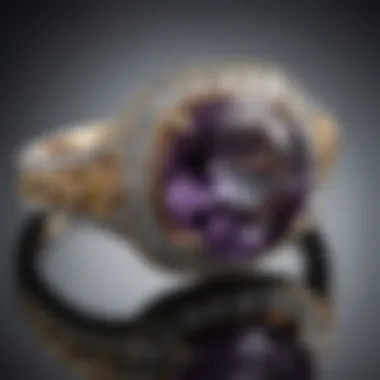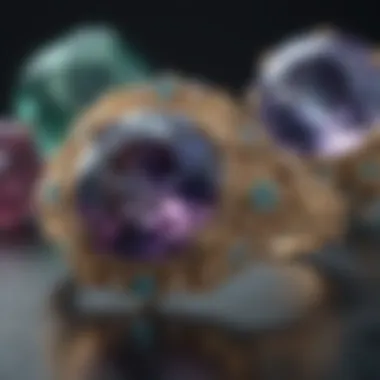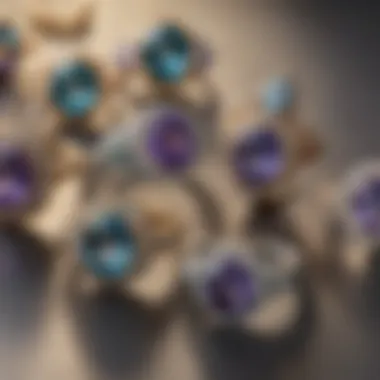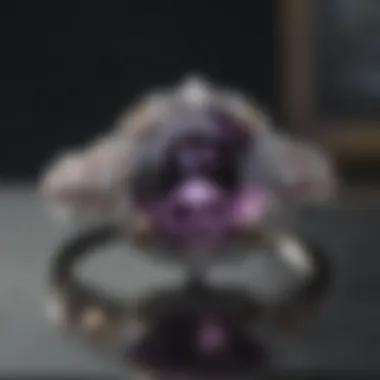Real Alexandrite Rings: An In-Depth Exploration


Intro
Alexandrite is a captivating gemstone that has fascinated people for centuries. This unique stone is known for its remarkable ability to change color, often shifting between green and red hues depending on the lighting. In the realm of jewelry, real alexandrite rings hold a special place for their rarity and beauty. In this article, we will explore various aspects of alexandrite rings, including their formation, unique properties, and the significance they hold in jewelry.
Overview of Gemstones and Minerals
Understanding gemstones begins with a broader knowledge of minerals. Gemstones are natural minerals that have been shaped and polished to produce beautiful adornments. Each gemstone possesses distinct characteristics that contribute to its appeal.
History of Gemstone and Mineral Use
Throughout history, gemstones have played significant roles in various cultures. People have used these stones not only for ornamental purposes but also for their believed metaphysical properties. For instance, ancient civilizations valued gemstones for their colors and rarity, using them in talismans and ceremonial items. The allure of alexandrite is an extension of this rich tradition.
Significance in Culture and Society
Gemstones often symbolize status, wealth, and beauty. In modern society, they continue to serve this purpose, especially in fine jewelry. Alexandrite, due to its scarcity and unique qualities, is particularly revered among collectors and enthusiasts.
Gemstone Formation and Properties
To fully appreciate alexandrite rings, one must understand how gemstones form and what properties define them.
Formation Process of Gemstones
Alexandrite is a variety of chrysoberyl, formed deep within the Earth under high pressure and temperature. The chemical composition, combined with the unique conditions of its environment, leads to the process which gives birth to this exceptional gemstone.
Properties that Define Gemstones
Each gemstone has specific physical and optical properties, including hardness, luster, and refractive index. Alexandrite stands out with its significant hardness, which is rated 8.5 on the Mohs scale, making it durable for everyday wear.
Classification based on Color, Hardness, and Luster
Gemstones can be classified by color, hardness, and luster. Alexandrite is particularly distinctive because of its color change, resulting from its unique crystal structure and the presence of chromium.
Types of Gemstones
A deeper exploration into gemstones reveals various classifications.
Precious vs. Semi-Precious Gemstones
Precious gemstones such as diamonds, rubies, sapphires, and emeralds are often perceived as more valuable than semi-precious stones. Alexandrite without a doubt qualifies as a precious stone due to its rarity and beauty.
Common Gemstone Varieties
Each gemstone has numerous varieties. In the case of alexandrite, it is distinct among other chrysoberyls, creating a niche for itself in high-end jewelry markets.
Exotic and Rare Gemstones
Alexandrite is among the rarest gemstones known. This rarity contributes to its status and appeal among collectors.
Identifying and Evaluating Gemstones
When purchasing an alexandrite ring, it is important to identify and evaluate the gemstone correctly.
Factors Affecting Gemstone Value
Several factors can influence the value of alexandrite, including color, size, clarity, and cut. The most sought-after stones display a vibrant color transition.
Techniques for Gemstone Identification
Professionals often use tools like refractometers and spectrometers to assess gemstones accurately. For collectors, understanding these techniques can aid in purchasing authentic pieces.


Assessing Gemstone Quality
Quality assessments often rely on the four Cs: color, clarity, cut, and carat weight. Alexandrite's value significantly increases when the color change is vivid and noticeable.
Caring for Gemstones
Proper maintenance ensures the longevity of alexandrite rings and enhances their beauty over time.
Cleaning and Storing Gemstones Properly
To clean alexandrite rings, use a mild soap and a soft brush. After cleaning, store the rings separately to avoid scratches.
Avoiding Common Mistakes in Gemstone Care
Avoid exposing alexandrite to harsh chemicals. Regular maintenance will help preserve the vibrancy of the stone.
Preservation Tips for Specific Gem Types
For optimal care, ensure that alexandrite is kept away from excessive heat and direct sunlight. This can help in maintaining its stunning color.
Ultimately, understanding the nuances associated with real alexandrite rings enhances appreciation and ensures informed purchasing decisions.
By providing insights into their formation, care, historical significance, and evaluation, this article aims to elevate the appreciation of alexandrite as a remarkable gemstone.
Preamble to Alexandrite
The world of gemstones is filled with beauty and rarity, but few stones capture attention quite like alexandrite. This exceptional gem stands out not only for its striking color-change properties but also for the rich history intertwined with its discovery and use. Understanding alexandrite is fundamental for enthusiasts and collectors alike, as it provides insight into its unique characteristics and appeal in the jewelry market.
Among the notable features of alexandrite is its ability to display a remarkable shift in color, typically green in daylight and a reddish-purple in incandescent light. This optical trait, along with its limited availability, contributes to its mystique and desirability. By delving into the definition and characteristics of alexandrite, one gains appreciation for its complexity.
Moreover, exploring the historical significance allows us to understand how alexandrite has transitioned from a coveted jewel in imperial Russia to a modern symbol of luxury. The journey of alexandrite offers valuable perspectives for anyone looking to invest in jewelry that embodies both beauty and rich heritage.
As we navigate through the details surrounding alexandrite, it is essential for prospective buyers and admirers to consider the gem's distinctive features and lore, ensuring they make informed choices in the marketplace.
The Formation of Alexandrite
The formation of alexandrite is a critical aspect to understand when exploring this unique gemstone. The processes that create alexandrite contribute directly to its rarity and value in the jewelry market. Alexandrite is a variety of the mineral chrysoberyl, and its beautiful color-changing properties stem from the specific geological conditions in which it is formed. By grasping how alexandrite is formed, enthusiasts and collectors can better appreciate its worth and characteristics.
Geological Conditions
The geological conditions leading to the formation of alexandrite are specific and essential. Generally, alexandrite is formed in metamorphic rocks and igneous rocks, where heat and pressure can encourage the right chemical reactions. These environments provide the necessary conditions for growth. The main locations for natural alexandrite production include Brazil, Russia, and Sri Lanka.
In detail, the geological processes involve high temperatures, which facilitate the transformation of aluminum oxide and beryllium into chrysoberyl. Further, the surrounding matrix must have specific elements like chromium to give alexandrite its remarkable color variations.
The likelihood of finding alexandrite largely depends on the geological rarity of these conditions. The precise balance of heat, pressure, and chemical components makes natural alexandrite formations quite extraordinary. As a result, gemstones that possess these features are seen as valuable and highly sought after.
The Role of Chromium
Chromium is the key element that promotes the captivating color change in alexandrite. It is because of chromium that alexandrite exhibits its exquisite ability to shift between green and red hues depending on light sources. In daylight, it appears more green; however, under incandescent light, it transforms to red. This striking phenomenon is a result of chromium's capacity to affect how the gem absorbs and reflects light.
The presence of chromium during the formation phase influences the gemstone's overall quality and value. A rich chromium content correlates with vibrant color changes and greater brilliance in the stone. Conversely, if chromium is sparse or absent, the gemstone fails to showcase the distinct qualities that make alexandrite adored.
"The use of chromium in the formation of alexandrite has significant implications for both its beauty and market value."
As a final point, the combination of the right geological factors and the essential role of chromium define the unique characteristics of alexandrite. Understanding these elements can enhance appreciation for this extraordinary gemstone, making it more than just a beautiful piece of jewelry.
Identifying Real Alexandrite
The ability to identify real alexandrite is crucial for anyone interested in these exquisite gemstones. Given their rarity and unique properties, distinguishing genuine stones from imitations is essential for collectors and jewelry enthusiasts. This section will explore key factors that contribute to identifying authentic alexandrite, including its color change phenomenon, clarity and cut, and fluorescence and pleochroism. Understanding these elements enhances both appreciation and investment in this remarkable gem.
Color Change Phenomenon


One of the most captivating features of real alexandrite is its remarkable ability to change color under different lighting conditions. This optical phenomenon is often highlighted as a defining characteristic of genuine alexandrite. In daylight or fluorescent light, real alexandrite typically exhibits a green to bluish-green hue. When viewed under incandescent light, it shifts to a reddish-purple or purplish-red coloration.
The intensity of this color change can vary between specimens. Some stones display a striking difference, while others show more subtle shifts. This variability adds to the allure of alexandrite. When examining an alexandrite, it is important to view it under both light sources to fully appreciate its unique color properties.
"Real alexandrite's color change is not just a feature, but the hallmark of its authenticity, making it highly sought after in jewelry markets."
Clarity and Cut
Clarity is another critical aspect of identifying real alexandrite. Like other gemstones, alexandrite can have inclusions or blemishes that may affect its appearance. Higher clarity stones are more valuable and desirable. Look for stones that are mostly free of visible inclusions, particularly when viewed under magnification. However, remember that some inclusions may be acceptable, as they can add character and provide insights into the stone's natural origins.
The cut of alexandrite also plays a significant role in its overall appeal and value. A well-cut alexandrite will reflect light beautifully, enhancing its color change effect. Common cuts include oval, cushion, and round, with the choice of cut often depending on the size and quality of the rough stone. A high-quality cut maximizes brilliance and showcases the gem's natural colors effectively.
Fluorescence and Pleochroism
Fluorescence can serve as another indicator in identifying real alexandrite. When exposed to ultraviolet light, many authentic alexandrite stones will display a strong fluorescence, often appearing more vivid or intense compared to their natural color under regular lighting. This phenomenon can help distinguish authentic stones from substitutes, which may not exhibit similar fluorescence.
Pleochroism is another fascinating characteristic of alexandrite. It refers to the ability of a gemstone to show different colors when viewed from different angles. In alexandrite, this is particularly evident as it often displays a combination of green, red, and sometimes yellow hues depending on the angle of observation. This quality is another unique signature that enhances the charm of the stone, but it can also be a challenging aspect for collectors and buyers to discern.
In summary, a careful evaluation of the color change phenomenon, clarity, cut, fluorescence, and pleochroism is essential for identifying real alexandrite. These factors collectively contribute to both its beauty and investment potential, making a thorough examination invaluable for enthusiasts and collectors alike.
Real Alexandrite Rings: A Detailed Look
In the realm of fine jewelry, real alexandrite rings hold a special place. Their unique properties and captivating beauty make them a sought-after choice for those looking to own a piece of nature’s art. This section will elaborates on the various elements that make these rings special, including design styles, setting options, and alternative materials. Understanding these aspects is crucial for enthusiasts and collectors who want to make an informed decision when considering the purchase of alexandrite rings.
Design Styles
When it comes to design, alexandrite rings can vary significantly in style. Some popular designs include solitaires, halo settings, and vintage styles. Each design offers a different way to showcase the unique color-change phenomenon of the stone.
- Solitaires emphasize the alexandrite by placing it as the centerpiece, allowing it to shine without distraction.
- Halo settings surround the alexandrite with smaller diamonds or other gemstones, accentuating its brilliance and color variance.
- Vintage styles often feature intricate metalwork and filigree detailing, enhancing the sophisticated appearance of the ring.
Design is not just about aesthetics; it's about how the ring will be worn and appreciated in daily life. Many collectors prefer unique designs that reflect personal taste and historical significance.
Setting Options
The setting of an alexandrite ring plays a significant role in its overall appeal. Common setting options include:
- Prong settings, which lift the stone off the band, providing maximum light exposure. This can enhance the visual impact of the color change.
- Bezel settings, which encase the stone in metal, offer a modern look while also providing excellent protection.
- Channel settings, which incorporate smaller stones into the band, creating a seamless flow while highlighting the central alexandrite.
Choosing the right setting not only affects the ring's beauty but also its durability. For example, prong settings can be prone to damage if snagged, while bezel settings offer more protection for the edges of the stone.
Alternative Materials
While gold and platinum are popular choices for alexandrite rings, alternative materials are gaining traction. These can provide unique looks and often come at different price points. For example:
- Sterling silver offers an affordable option that still allows the alexandrite to shine.
- Palladium is a lighter metal that can be a great alternative to platinum, providing a similar look with a more affordable price.
- Rose gold has become increasingly popular, adding a romantic warmth that pairs beautifully with the changing colors of the alexandrite.
When considering alternative materials, it's important to also think about potential allergic reactions and maintenance. Each material requires different care to maintain its appearance over time.
"The choice of materials and design styles in alexandrite rings can greatly influence their appeal and value. Understanding these choices is essential for any serious collector or buyer."
Overall, the detailed look into design styles, setting options, and alternative materials provides a comprehensive guide to understanding what makes real alexandrite rings stand out in the jewelry market.
The Value of Alexandrite in Jewelry
The value of alexandrite in jewelry extends beyond its aesthetic appeal; it encapsulates a rich tapestry of history, rarity, and market dynamics. For gemstone enthusiasts and collectors, understanding the multifaceted value of alexandrite rings is essential for making informed purchasing decisions. These rings not only serve as stunning adornments but also as tangible investments that can appreciate over time.
Market Trends
In recent years, the alexandrite market has exhibited intriguing trends influenced by various factors. Increasing demand for unique and rare gemstones has placed alexandrite at the forefront. With its exceptional color-changing properties, it stands out in comparison to other gemstones. Buyers are keen to acquire pieces that provide not just visual appeal but also a sense of exclusivity.


Moreover, social media platforms have played a significant role in popularizing alexandrite jewelry. Influencers and collectors share their purchases online, sparking interest and fueling demand. The rise of online jewelry marketplaces also increases accessibility for both buyers and sellers, enhancing market fluidity. This accessibility, combined with the stone’s captivating characteristics, pushes prices upward, affirming alexandrite’s status as a luxury item.
In summary, market trends indicate a parallel trajectory of rising interest, enhancing its value in jewelry.
Investment Potential
When considering investment potential, alexandrite rings present a unique opportunity. Their rarity contributes significantly to their value—natural alexandrite is rare, especially in larger carat sizes. As collectors seek these gems, the demand only grows.
Investing in alexandrite requires careful consideration. Here are some key points to keep in mind:
- Quality Matters: Higher quality stones with richer colors and fewer inclusions yield better investment returns.
- Certification: Ensuring that your alexandrite comes with an accurate certification is vital. This documentation authenticates the gem and verifies its origins and properties.
- Market Research: Keeping abreast of industry developments and market conditions can influence your investment decisions. Understanding supply and demand dynamics allows for strategic purchasing.
- Long-Term View: Like any investment, alexandrite requires a long-term commitment. Short-term fluctuations can occur, but genuine collectors recognize the long-term potential of these stones.
"Alexandrite serves as both a stunning piece of jewelry and a valuable asset, making it an attractive choice for dedicated collectors."
Caring for Alexandrite Rings
Taking care of alexandrite rings is crucial for preserving their beauty and integrity over time. Alexandrite is a unique gemstone known for its color-changing properties and rarity. Because of this, maintaining its condition is vital for allowing its true nature to be appreciated fully. Proper care can also enhance its value, making these rings not only beautiful accessories but also sound investments for collectors and enthusiasts alike.
In the realm of jewelry, rings made from real alexandrite can be delicate. They are prone to scratches and can lose their luster if not handled with care. Understanding how to clean and store alexandrite rings is essential for extending their life and ensuring they remain striking additions to any collection.
Cleaning Techniques
Cleaning techniques for alexandrite rings should focus on methods that are safe and effective, without causing damage. Here are some recommended approaches:
- Use mild soap and water: The simplest way to clean an alexandrite ring is with a mixture of warm water and mild soap. Avoid abrasive cleansers, which can scratch the surface or dull the gem's brightness.
- Soft cloth or brush: A soft cloth or a toothbrush with gentle bristles can effectively clean the ring. This helps remove dirt and oils that accumulate over time.
- Rinse thoroughly: After cleaning, rinse the ring under warm running water to ensure all soap is removed. This prevents any residue from impacting the stone's appearance.
- Dry gently: Use a soft, dry cloth to gently pat the ring dry after rinsing. Avoid abrasive materials that could scratch the alexandrite.
It is advisable to avoid steam cleaners or ultrasonic cleaners, as they may damage the gemstone or its setting.
Storage Recommendations
Storing alexandrite rings properly is equally important to ensure their longevity. Here are some tips for effective storage:
- Individual pouches or boxes: Store each alexandrite ring in its own pouch or a lined box. This prevents scratches from contact with other jewelry pieces.
- Avoid direct sunlight: Keep the rings in a cool, dark place, shielded from direct sunlight, which can cause the color to fade over time.
- Climate control: Maintain a stable temperature and humidity level in the storage area. Extreme changes can affect the integrity of the gemstone.
Proper care and storage can dramatically prolong the aesthetics and value of an alexandrite ring, allowing its unique beauty to shine through for generations.
Integrating these cleaning techniques and storage recommendations into your jewelry care routine will ensure that your alexandrite rings remain as stunning as the day they were acquired. By investing time into their upkeep, collectors and enthusiasts can truly enjoy their vivid colors and remarkable charm for many years.
Ethical Considerations in Alexandrite Sourcing
The discussion around ethical sourcing of gemstones has gained much attention in recent years. It is vital to understand the impact of mining practices on communities and the environment when considering purchases of real alexandrite rings. Alexandrite, due to its rarity and beauty, tends to attract various mining operations. However, not all practices adhere to ethical standards. Ensuring that the gemstones are sourced responsibly has become not just a choice, but a necessity for conscious consumers and collectors.
Sustainable Mining Practices
Sustainable mining practices are crucial in limiting the negative impact on the environment. The methods were used to extract alexandrite need to prioritize environmental stewardship. This involves minimizing land degradation and protecting biodiversity. Sustainable practices include:
- Rehabilitation of mining sites: After extraction, the area must be restored to its natural state to prevent erosion and habitat loss.
- Water management: Efficient usage of water and treatment of wastewater is essential to safeguard local water resources.
- Community involvement: Engaging local communities in mining processes ensures that the benefits are shared and customs respected.
By promoting sustainable mining, consumers can make informed choices when purchasing alexandrite rings. This conscious decision can strengthen market demand for ethically sourced stones, encouraging miners to adopt better practices.
Certification of Authenticity
The certification process plays a significant role in ensuring the authenticity and ethical origins of alexandrite. Certifications provide assurance to buyers that the stones have been sourced responsibly, following ethical guidelines. Important aspects of certification include:
- Traceability: Certified gemstones can usually be traced back to their source, revealing the mining methods used.
- Standards compliance: Certifications often adhere to international standards or guidelines like the Kimberley Process, which aims to prevent conflict diamonds from entering the market.
- Transparency: Certifications increase transparency, ensuring that all parties—from miners to consumers—are informed about the origins and quality of alexandrite.
The End
The importance of the conclusion section in this article cannot be understated. This part synthesizes the detailed exploration of real alexandrite rings, encapsulating the essence of the entire discussion. It allows readers to reflect on the multifaceted dimensions of alexandrite, its historical significance, unique formation, and the values it holds in today's jewelry market.
Future of Alexandrite Rings
As we look ahead, the future of alexandrite rings appears intriguing. The rarity of natural alexandrite, coupled with its unique color-changing properties, ensures its continued desirability among gemstone enthusiasts and collectors. Furthermore, the rising interest in sustainable and ethically sourced gemstones will likely influence the market dynamics.
- Increased Demand: As collectors grow more discerning, the demand for authentic, ethically sourced alexandrite may surge.
- Technological Developments: Advances in gemstone identification technology will help buyers better discern authenticity and quality, potentially phasing out lower-quality stones from reputable markets.
- Market Trends: Florishing online platforms and marketplaces will make alexandrite more accessible, fostering broader appreciation and sales.
- Design Evolution: Jewelers may explore innovative designs and settings that highlight the distinct qualities of alexandrite, further enriching its narrative in modern jewelry.
In summary, the future of alexandrite rings is promising, and the ongoing interest in sustainable sourcing and innovative designs may pave the way for more appreciation and recognition of this unique gemstone. Its allure as a symbol of elegance and rarity will likely resonate with a new generation of jewelry lovers.







